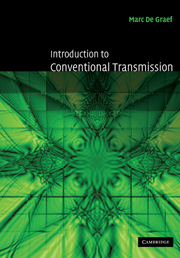Book contents
- Frontmatter
- Contents
- Preface
- Acknowledgements
- Figure reproductions
- 1 Basic crystallography
- 2 Basic quantum mechanics, Bragg's Law and other tools
- 3 The transmission electron microscope
- 4 Getting started
- 5 Dynamical electron scattering in perfect crystals
- 6 Two-beam theory in defect-free crystals
- 7 Systematic row and zone axis orientations
- 8 Defects in crystals
- 9 Electron diffraction patterns
- 10 Phase contrast microscopy
- Appendix A1 Explicit crystallographic equations
- Appendix A2 Physical constants
- Appendix A3 Space group encoding and other software
- Appendix A4 Point groups and space groups
- List of symbols
- Bibliography
- Index
6 - Two-beam theory in defect-free crystals
Published online by Cambridge University Press: 02 December 2009
- Frontmatter
- Contents
- Preface
- Acknowledgements
- Figure reproductions
- 1 Basic crystallography
- 2 Basic quantum mechanics, Bragg's Law and other tools
- 3 The transmission electron microscope
- 4 Getting started
- 5 Dynamical electron scattering in perfect crystals
- 6 Two-beam theory in defect-free crystals
- 7 Systematic row and zone axis orientations
- 8 Defects in crystals
- 9 Electron diffraction patterns
- 10 Phase contrast microscopy
- Appendix A1 Explicit crystallographic equations
- Appendix A2 Physical constants
- Appendix A3 Space group encoding and other software
- Appendix A4 Point groups and space groups
- List of symbols
- Bibliography
- Index
Summary
Introduction
Most x-ray diffraction experiments are designed to increase the probability that a reciprocal lattice point will fall on the Ewald sphere. This is usually not a problem for electron diffraction, since the radius of the Ewald sphere is much larger, as we have seen in Chapter 2. It is, therefore, ironic that the most basic TEM technique involves minimizing the number of lattice points on the Ewald sphere! Indeed, the most popular conventional TEM technique relies on the use of only two electron beams, the transmitted beam and a single scattered beam. In many cases, we have to work hard at getting only one diffracted beam. The shorter the wavelength, the more reflections will fall on or close to the Ewald sphere for any given crystal orientation. Furthermore, if the direct space lattice has a large unit cell, then reciprocal space will be filled densely with lattice points and hence two-beam microscopy becomes progressively more difficult with increasing unit cell size.
There is a good reason for the use of two-beam techniques: the theory becomes mathematically more tractable and closed-form solutions to the dynamical scattering equations are known. Intuitively, it makes a lot of sense to study a crystal by looking at one set of lattice planes at a time. For instance, when studying dislocations, the displacement field around the dislocation core causes lattice planes to distort. For a given dislocation type, certain lattice planes may remain undistorted and the two-beam technique allows identification of these undistorted lattice planes, thus providing valuable information concerning the displacement field of the dislocation.
- Type
- Chapter
- Information
- Introduction to Conventional Transmission Electron Microscopy , pp. 345 - 394Publisher: Cambridge University PressPrint publication year: 2003



